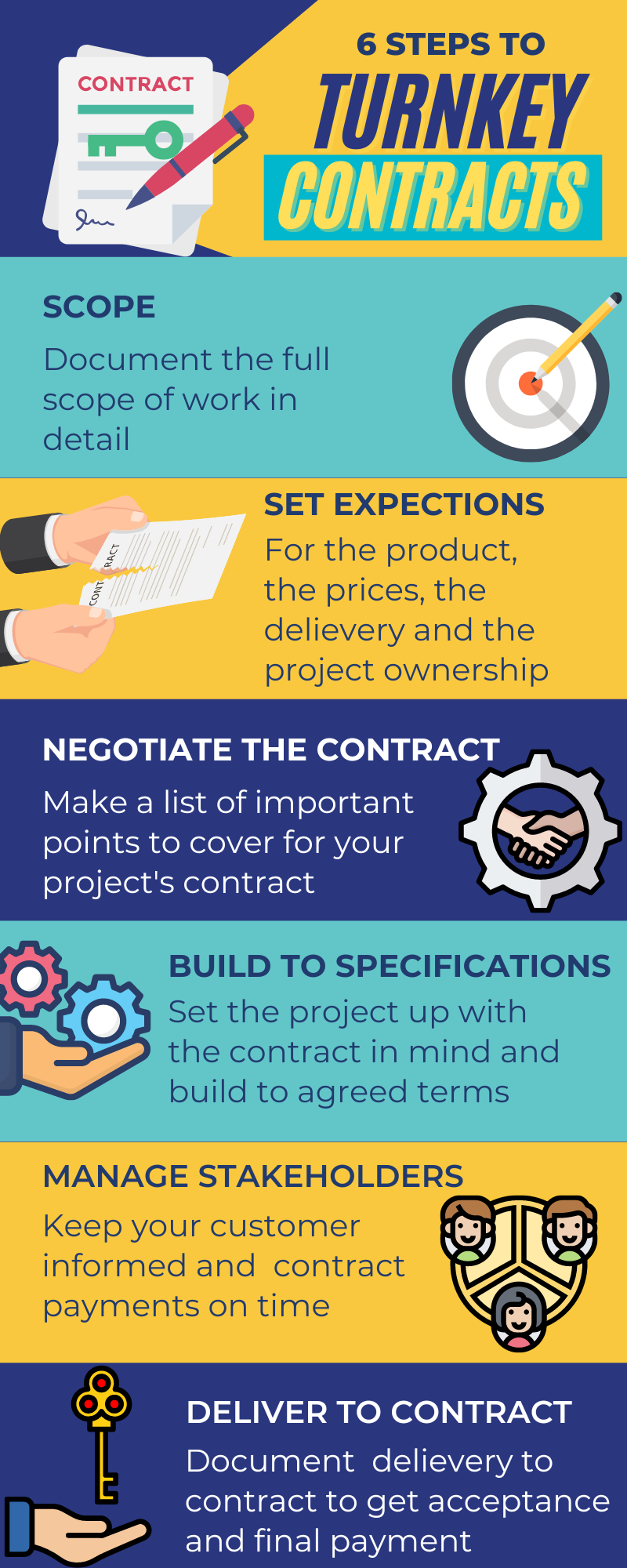How To Use A Turnkey Contract For Your Project
Contracting is an important part of most any Project. It's important to know the types of contracting options and the pros and cons of each choice. Turnkey contracts can create an effective and efficient buying option for the client and a lock-step delivery for the Supplier's project team. That is, if it is done right.
This article is part of my Project Fundamentals series. For a summary of my videos in this series, click here.
Turnkey Contract Steps
Scope the end product correctly
Set expectations of the product and the process
Negotiate the right contract
Build to specifications
Manage the customer interactions
Deliver per the contract
What is a turnkey contract?
If the Project is Turnkey the Contract can be Turnkey too.
A turnkey contract is used when the Buyer and Supplier agree to a set price for work or a final product based on specific or standard requirements. This includes commodities or established products where the Buyer knows what they are getting, and the seller understands the product and the cost drivers to allow the cost to be set in advance. Generally, contracts like these are used where the client has no involvement or very limited involvement in the product build. The Buyer takes ownership of the product or deliverable at completion. The Buyer may pay at build milestones or on delivery.
Projects that use a turnkey approach can vary. Some examples would be:
a commercial building construction
a technology build, such as an app with standard or detailed specifications
a piece of equipment build with standard and customized requirements
a project to manage logistics or an event
The work to design the project may be the only time the client has feedback on the design. The Project Team is defined and managed by the Supplier. The turnkey contract is also known as Turnkey Bid. Engineering, Procurement, and Construction contracts, also known as EPC contracts, can also be referred to as turnkey contracts.
The selected contractor takes all the responsibilities, from design to the delivery of the project after its completion. Once the deal is done, the Buyer does not have to worry about anything. It is the contractor's job to complete the project. The contractor or Supplier will choose the process, team, materials, and tools needed to achieve the result. They don't have to make the product according to the Buyer's instructions. However, the contractor will need to meet requirements for specifications and materials if named in the Contract. Documentation, data privacy, and regulations are generally the Supplier's responsibility. When the product is complete, the ownership is ready to transfer. This is often termed handing over the 'keys' to the Buyer, hence "turnkey.'
When do Turnkey Contracts Work best? A turnkey contract is the best fit when the Buyer knows what they want and has clear and detailed specifications, which the Supplier can deliver. Need some Contracting Tips? See this video and download my free guide The Key to Contracting.
When is a Turnkey Contract the right choice?
When the specifications are limited and knowable.
When the Buyer understands the process.
When the Supplier has a reliable team and process for producing to the contract specifications.
When the Buyer does not have the staffing or expertise to oversee the project outcome.
When the Supplier has local knowledge, contacts, and staff to execute in locations where the Buyer does have access.
When is a Turnkey Contract the wrong choice?
When the Buyer does not understand their needs and wants.
When the Buyer has the staffing available and connections needed to deliver or oversee the project.
When the End-User's persona and needs are not well documented.
When the Technology is specific to the Buyer and requires special customizations and approvals within the Buyers organizations.
When risks include mitigation actions outside the bounds of the Supplier.
What is the aim of a turnkey contract?
A turnkey contract allows the Buyer to review all the available options to complete the project with its required quality, capacity, and due date. The Supplier needs to focus on requirements, milestones, quality assurances, documentation needed, and due date. They also need to agree to the pay schedule.
The Buyer and supplier must ensure they can deliver the contract product for the right price. For the Buyer, this often equates to the lowest bidder for the quality needed. In contrast, the supplier needs to calculate the cost, including a contingency, plus profit. The Supplier also needs to ensure they can deliver. The Buyer will most often use a bid process to select the supplier based on set criteria.
There are some points to consider in all situations for both the Buyer and the supplier.
Five critical components of a turnkey contract
Every Turnkey contract should meet some basic criteria to allow clear expectations, contractual terms, and contract management. Ultimately, the most important aspect of the contract is that it sets the project up for success to allow the product to meet the Buyer's and their end-users needs.
A Clear Scope and Design
Both the Supplier and the Buyer are incentivized to create a clear specification of scope and solution design for the end product. This may look different for a project vs. an event; however, the more detailed this document, the higher the chances for success in both the project and the contract.
The Technical Components
The Supplier needs to focus on their technological readiness to deliver. The Buyer will also need to ensure that the solution will fit into their current technology landscape. If Technology is key to the solution, scoping product plug-ins, version, data migration, and cut-over planning (including maintenance and downtime) should be included in the planning, scope, and cost estimates).
The Material or Staffing List
In some situations, the Buyer may ask the Supplier to list the materials or team members used in the project. This may be due to compliance, regulatory needs, or product fit.
Government contractors may also need to vet the staff or require they pass a credential or certification review. In some cases, a buyer may restrict the contractor, limiting the options to specific supplies or subcontractors. The Buyer may want to ensure the quality of particular aspects at this point. Buyers may also bargain on the price of certain subcontractors.
Risk and Mitigation Assessment
A risk assessment is another crucial component of any turnkey contract for both parties. The goal is a successful outcome. Taking the time to assess the possible risks and how they may be mitigated is important. It is also important to agree to a mitigation plan since a turnkey contract is priced based on the Supplier's best options for the project approach, including mitigation of issues. If the Buyer does not agree with the mitigation approach, this can create unplanned delays or increased costs that the Supplier has not accounted for. Because the Supplier is responsible for every element of the project, the Supplier must know what can go wrong and how they plan to course-correct if needed.
Price
As previously said, one of the essential parts of a turnkey contract is the price. As the Supplier, be careful to balance the bid price against the outcome. As the Buyer, be aware that the lowest price may not be realized due to cost increases for any change. False economies on pricing can mean the wrong project, team, and outcome. Choosing the best fit for the Supplier is often the cheaper solution in the long run.
In summary
Turnkey contracts are a way for Buyers to get what they want at a fixed price and for Suppliers to have the flexibility to deliver effectively and efficiently to protect their profit margins.
Turnkey Contracts work if both parties are clear and transparent in agreeing to Scope, Timelines, and Costs. And the Buyer understands that Turnkey will limit their ability to drive the way things are done (no parachuting into the project and calling the shots).
Do you have experience with Turnkey Contracts? How did it go for you? Were you the Buyer or the Supplier? Did I miss anything? Let me know in the comments below.






